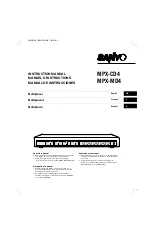
Calibration
2-2
2.2
Environmental conditions
Calibration procedures should be performed at an ambient
temperature of 23° ± 5°C, and at a relative humidity of less
than 80% unless otherwise noted.
NOTE
If the instrument is normally used over a
different ambient temperature range, cali-
brate the instrument at the center of that
temperature range.
If the internal temperature of the Model 2002 drifts exces-
sively during calibration, an error will be generated. See
Appendix C for additional information.
2.3
Warm-up period
The Model 2002 must be allowed to warm up for at least four
hours before calibration. If the instrument has been subjected
to temperature extremes (outside the range stated in para-
graph 2.2), allow additional time for internal temperatures to
stabilize. Typically, it takes one additional hour to stabilize a
unit that is 10°C (18°F) outside the specified temperature
range.
NOTE
Placement of the OPTION SLOT cover
affects the internal temperature of the
Model 2002. To achieve T
CAL
± 1°C spec-
ifications, the OPTION SLOT cover must
be in the same position (on or off) as when
the Model 2002 is to be used.
The calibration equipment should also be allowed to warm
up for the minimum period specified by the manufacturer.
2.4
Line power
The Model 2002 should be calibrated while operating from
a line voltage in the range of 90-134V or 180-250V at 50, 60,
or 400Hz.
2.5
Calibration lock
2.5.1 Comprehensive calibration lock
Before performing comprehensive calibration, you must first
unlock calibration by momentarily pressing in on the
recessed CAL switch. The instrument will display the fol-
lowing message:
CALIBRATION UNLOCKED
Calibration can now be performed
If you attempt comprehensive or low-level calibration with-
out performing the unlocking procedure, the following mes-
sage will be displayed:
CALIBRATION LOCKED
Press the CAL switch to unlock.
Note that it is not necessary to unlock calibration for the AC-
only self-calibration procedure. Also, IEEE-488 bus calibra-
tion command queries such as the :DATE and :DATA com-
mands are not protected by the calibration lock.
2.5.2 Low-level calibration lock
To unlock low-level calibration, press in and hold the CAL
switch while turning on the power. Low-level calibration can
then be performed.
NOTE
Do not unlock low-level calibration unless
you have the appropriate equipment and
intend to perform low-level calibration.
See paragraph 2.10 for low-level calibra-
tion details.
2.5.3 IEEE-488 bus calibration lock status
You can determine the status of either calibration lock over
the bus by using the appropriate query. To determine com-
prehensive calibration lock status, send the following query:
:CAL:PROT:SWIT?
The instrument will respond with the calibration lock status:
0: comprehensive calibration locked
1: comprehensive calibration unlocked
To determine the status of the low-level calibration lock,
send the following query:
:CAL:PROT:LLEV:SWIT?
Responses to this calibration lock query include:
0: low-level calibration locked
1: low-level calibration unlocked
Refer to paragraph 2.6 below and Section 3 for more details
on calibration commands.
2.6
IEEE-488 bus calibration commands
Table 2-1 summarizes calibration commands used to cali-
brate the instrument over the IEEE-488 bus (GPIB).
Содержание 2002
Страница 1: ...Model 2002Multimeter Calibration Manual A G R E A T E R M E A S U R E O F C O N F I D E N C E...
Страница 9: ...iv...
Страница 11: ...vi...
Страница 55: ...Calibration 2 26...
Страница 70: ...Specifications A 1 A Specifications...
Страница 83: ...A 14 Specifications...
Страница 101: ...Calibration Programs B 18...
Страница 113: ......
















































